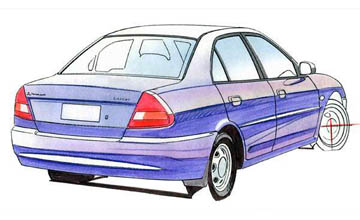BY MALCOLM LIVERMORE | 21st Feb 2001

Although as a sedan the Lancer does look like a baby Magna, which has been praised for its good looks and trendsetting "edge design".
The tail-lights are almost a direct replica of those on the new Magna, emphasising Mitsubishi's family look.
The Lancer's new body also cuts a slippery figure having a low drag co-efficient of just 0.30.
The new body delivers slightly more front and rear headroom and is slightly longer and taller than the old model.
All other dimensions are unchanged. Its low drag figure, light weight and revised 1.5-litre and 1.8-litre engines deliver good fuel economy both in town and on the highway.
The 1.5-litre, 12-valve engine now comes with fuel-injection and develops 69kW, 5.8 per cent up on the superseded engine.
The 1.8-litre, 16-valve powerplant, improved from the previous car, develops a healthy 86kW at 5500rpm and 161Nm of torque at 4500rpm.
Performance from this engine is strong and more refined.
It offers a broader spread of torque than the 1.5-litre motor, which tends to get loud and breathless above 5000rpm.
Mitsubishi has fallen into line with the rest of world's front-drive car-makers by switching its engine layout from west-east to east-west.
The engines mate to the standard five-speed manual gearbox and what is perhaps the most sophisticated four-speed gearbox in the small car market.
Dubbed IVECS II, it uses "fuzzy logic" to optimise gear changes to suit the driver's style and the road conditions.
The automatic gearbox delivers crisp, clean gear changes that put it at the top of the class for refinement and smoothness.
But overall the car does not win any noise, vibration and harshness contests as there is still too much road and tyre noise from the front end. This problem is a carry-over from the old car and although it is much improved, the new model is still below the standards of the best in the class.
The MacPherson strut front suspension and independent multi-link rear end are virtually carried over from the old model and deliver a ride and handling compromise that puts the Lancer firmly in the middle of the pack.
With relatively narrow, tall tyres, the Lancer's handling is rather limited and its light weight means it feels insubstantial and nervous when pushed beyond the bounds of day-to-day driving.
The Lancer, even when fitted with the 1.8-litre engine, is restricted to 13-inch wheels.
It wins points with its modern dash mirroring some of the touches found in the new Magna. The grey plastic is high quality, if quite drab, but well put together and functional.
For drivers needing a large, well-shaped boot, Lancer could be the answer.
The revised rear end provides a boot that is among the most capacious in its class and its lid opens down to bumper level for convenient loading.
Equipment levels are acceptable although the lack of a cassette player or optional CD player on 1.5-litre models seems to be a rather bold omission.
Where the Mirage stands out in the light car class, its four-door sedan brother struggles to reach similar heights in the more sophisticated small car market.
It offers some worthy improvements over the superseded model but fails to offer any real benefits over its opposition.
- Automotive NetWorks 05/07/1999